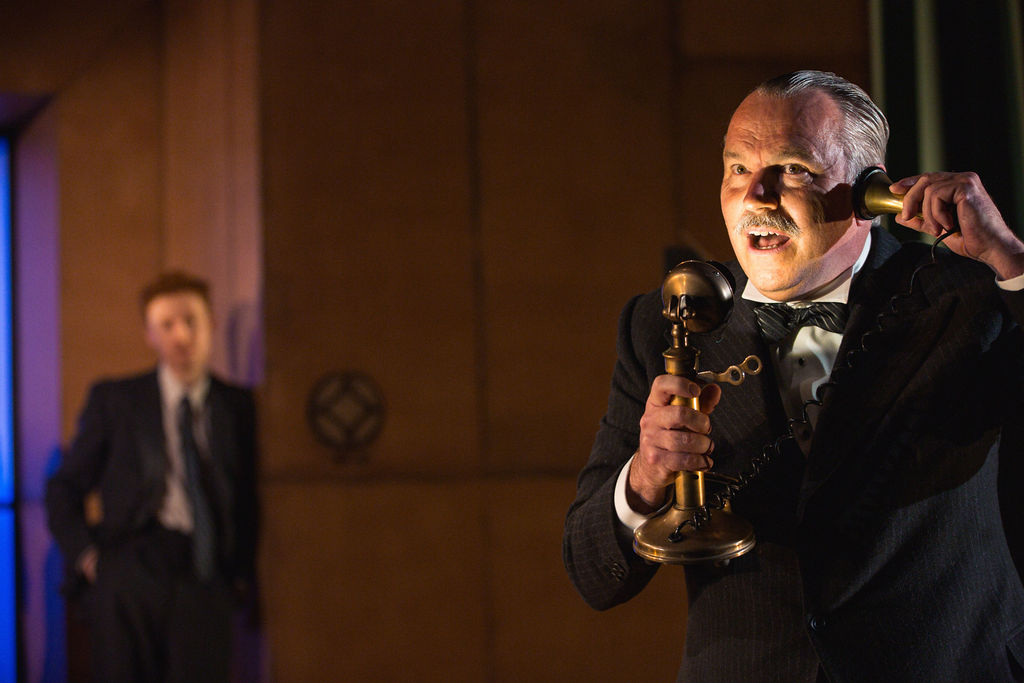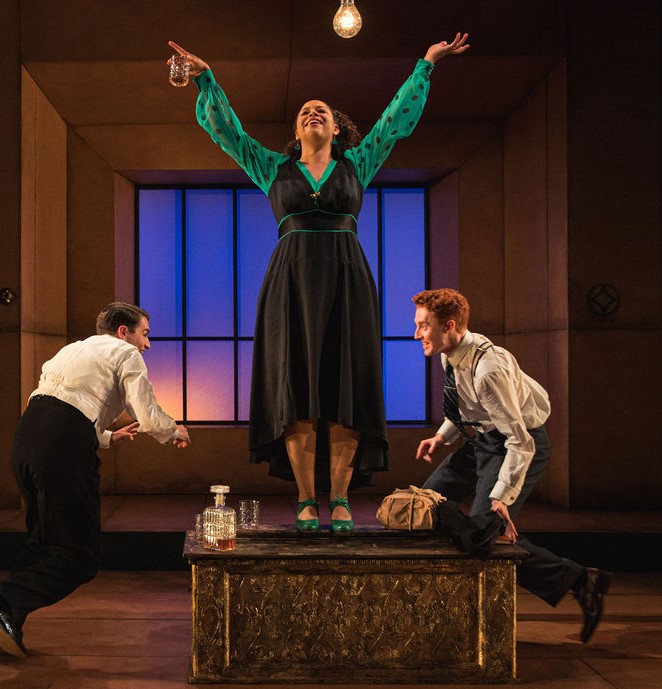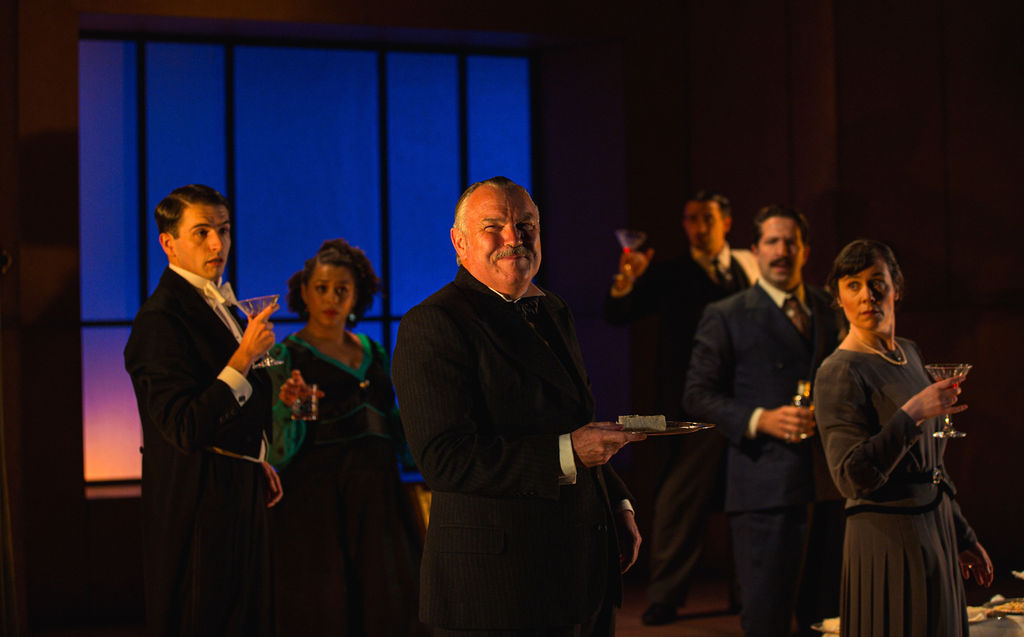
 (5 / 5)
(5 / 5)
There’s nothing like a good murder mystery to inspire the senses and get the cogs whirring as to whodunnit. Yet, with Rope we are aware from the outset of the identity of the victim as well as knowing who the guilty parties are. The question is, will they get away with it?
Rope is said to be inspired by a real-life crime: the murder of 14-year-old Bobby Franks in 1924 by University of Chicago students Nathan Leopold and Richard Loeb. Written by playwright Patrick Hamilton in 1929, also the year in which the piece is set, this intense, dark comic drama is one that deals with death, power, superiority, and jealousy.
In 1948, Alfred Hitchcock’s film version was released, although several changes were made to the original play- the setting relocated to New York City and various character names and traits altered. It was the first of Hitchcock’s technicolour films but unfortunately it failed to succeed at the box office; with Chicago Tribune‘s Mae Tinee stating ‘if Mr. Hitchcock’s purpose in producing this macabre tale of murder was to shock and horrify, he has succeeded all too well. The opening scene is sickeningly graphic, establishing a feeling of revulsion which seldom left me during the entire film’- not a tactic this cast and creative team needed to rely on.
For anyone interested, there is also a 1983 BBC Radio 4 dramatisation of the play starring Alan Rickman as Rupert Cadell.
Set on the first floor of a London house, two young men have murdered a fellow student, merely for ‘adventure,’ and they have hidden the body in a large chest. In a macabre turn, they host a party for the victim’s oblivious family, utilising said chest as a buffet table! We arrive to an open set- a simple set with large French windows (perhaps to the soul?!), a non-descript chest in the centre and a single light bulb dangling from the roof. We know the action is about to begin when the light bulb flickers and we are plunged into darkness. The lighting in this production is a character in itself- a constant play between light and dark, not only physically (through the use of matches, stage lights, lanterns and much more besides) but also in its qualities and dialogue. We see the growing madness of Granillo, racked with fear and guilt, juxtaposed with the calm, sadistic exterior of Brandon, as well as the genius comic timing and nature of Sabot, the butler, who seems to be the welcome lightness- with his witty banter and wonderful physical presence..

(Photo credits: Andrew AB)
Physical theatre lends itself perfectly to this production and is employed brilliantly- not only for individual characters and in varying other forms, but, most impressively, to imply the passage of time as the guests make their way around the chest, picking their chosen nibbles, pouring their drinks etc. You could be led to believe that these sections are cleverly improvised but we know they are choreographed to the inch- staging of the highest quality!

Another interesting addition to the staging is the era-appropriate speakeasy style tables and chairs and a piano, placed on the floor either side of the stage where our characters watch the action unfold. During the 1920s, radio also emerged as a cornerstone of entertainment and communication, so in keeping with this idea, we are offered radio-esque announcements which introduce us to each character as they appear for the first time. This not only adds to the atmosphere of the piece but clarifies characters and context for the audience.

The piece is cast perfectly, each performer faultless in their delivery. The dialogue is gripping, despite its age and the aesthetics leave us wanting more. The ‘rope’ is an emblem for everything that this play is about- the physical portion of rope the light bulb swings from and that which is used to kill its victim, the question of how much ‘rope’ will the guilty be given as time ticks by and the thought of the rope which may eventually be used to hang our perpetrators should they be found out.
An innovative, captivating, and timeless performance. Rope is theatre at its most alluring and everyone should see it!
Rope completes its run at Theatr Clwyd on July 20th.
Cast:
Jack Hammett: Wyndham Brandon
Chirag Benedict Lobo: Granillo
Felipe Pacheco: Sabot
Rhys Warrington: Kenneth Raglan
Emily Burnett: Leila
Keiron Self: Sir Johnstone Kentley
Emily Pithon: Mrs Debenham
Tim Pritchett: Rupert Cadell
Creative Team:
Director: Francesca Goodridge
Set and Costume Design: Good Teeth
Lighting Design: Ryan Joseph Stafford
Composer and Sound Design: Dyfan Jones
Movement Director: Jess Williams
Fight Director: Kev McCurdy
Assistant Director: Dena Davies
Casting Director: Polly Jerrold
Company Stage Manager: Lizzie O’Sullivan
Deputy Stage Manager: Natasha Guzel
Assistant Stage Manager: Emma Hardwick

Another gripping and engaging play from Francesca Goodridge and Theatr Clwyd. 👏👏👏Loved it on the first night, and am going back to see it again. ❤️🎭🏴
A clever evisceration of a slightly dated piece, getting the absolute most out of the mannerisms and the banal expressions used at the time – the 1920s – and designed to appeal to an audience force fed murder stories on television. Keeping the dialogue to essentials and organising the action with an ingenious mixture of mime, clowning, dance and acrobatics, made for a memorable evening. Perhaps the only weakness in the production was that the reduction of the original text meant the characters remained slightly limited – dialogue does allow more room for exploration. Thus Brandon was more conceited than evil; the women were necessarily comic stereotypes – and the ending was never in doubt. The audience appreciated the show, though, indicating that the style used in reviving the play was both appropriate and not overdone. Congratulations to all involved.